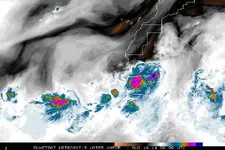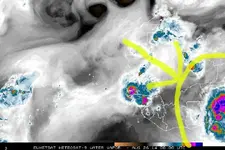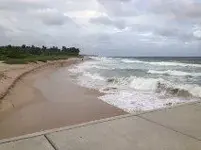You are using an out of date browser. It may not display this or other websites correctly.
You should upgrade or use an alternative browser.
You should upgrade or use an alternative browser.
storms rolling off of Africa (tropics heating up)
- Thread starter GatorBoy
- Start date
lost items recovery
Bronze Member
Be safe down by the water everyone
Sent from my iPhone using TreasureNet
Sent from my iPhone using TreasureNet
Amazon Forum Fav 👍
Boatlode
Bronze Member
- Joined
- Mar 30, 2014
- Messages
- 1,729
- Reaction score
- 3,039
- Golden Thread
- 0
- Location
- Florida Treasure Coast
- Detector(s) used
- Tesoro Sand Shark......
Nokta Pulse dive....
Scubapro Jet Fins...................
Mares Puck dive computer.......
Sherwood Silhouette BCD.......
Poseidon Cyklon 300 regulator...
- Primary Interest:
- Shipwrecks
Surf was definitely up today. I was detecting in the wet sand and almost got knocked down a couple times.
seeker41
Bronze Member
- Joined
- Feb 18, 2007
- Messages
- 1,706
- Reaction score
- 368
- Golden Thread
- 0
- Location
- spacecoast florida
- Detector(s) used
- fisher cz6a--teknetics g2 --cz20--minelab excal 800--discovery3300--original whites tdi--tesoro sandshark--whites dual field
- Primary Interest:
- All Treasure Hunting
cristobal is now a cat 1 and moving east at two mph if it keeps it up it may drift closer to us than expected!!!!!
if it keeps it up it may drift closer to us than expected!!!!!
two other disturbances and some good looking waves yet to leave africa,..........definitely heating up and seems allot more active with storms not fizzling out like last year.
chuck.
 if it keeps it up it may drift closer to us than expected!!!!!
if it keeps it up it may drift closer to us than expected!!!!!two other disturbances and some good looking waves yet to leave africa,..........definitely heating up and seems allot more active with storms not fizzling out like last year.
chuck.
sponge
Bronze Member
Just got back, looks like we are starting to give up some sand. I found someone's ear cushion from a set of headphones. Hope that hunter is okay. Surf really startin to increase in size. Turtle nest are being exposed and taken out to sea. Gonna get back out again shortly. HH all
sponge using smoke signals.
sponge using smoke signals.
lost items recovery
Bronze Member
Guys I got you. Go down at low tide dig a hole about 6ft down...put a bucket in the hole wait till storm is over... Your bucket will be full of gold because gold always settles in the lowest point!
Your welcome!
Sent from my iPhone using TreasureNet
Your welcome!
Sent from my iPhone using TreasureNet
el padron
Hero Member
- Joined
- Oct 29, 2010
- Messages
- 920
- Reaction score
- 503
- Golden Thread
- 0
- Location
- Southern California
- Detector(s) used
- The content of this space is contingent upon principals acceptance, execution and or final disposition / funding of an approved product endorsement agreement
- Primary Interest:
- Other
Good bunch of info there thank you.
I suppose putting a category 4 in the position to push water into a bend or bay at the right angle would funnel the storm surge in and push way back.
Katrina was also a category 5 pushing in for a good distance
Katrina was a barely a category 3. Any storm actually hitting landfall as a five is highly improbable and would have permanently altered the coastline. It arguably has never happened.
Last edited:
lookindown
Gold Member
Makes sense to me.Guys I got you. Go down at low tide dig a hole about 6ft down...put a bucket in the hole wait till storm is over... Your bucket will be full of gold because gold always settles in the lowest point!
Your welcome!
Sent from my iPhone using TreasureNet
GatorBoy
Gold Member
- Joined
- May 28, 2012
- Messages
- 14,716
- Reaction score
- 6,156
- Golden Thread
- 0
- Primary Interest:
- All Treasure Hunting
- #93
Thread Owner
Katrina was a barely a category 3. Any storm actually hitting landfall as a five is highly improbable and would have permanently altered the coastline. It arguably has never happened.
It was pushing water as a five also a four..the conversation was about storm surge...which I think I have a good grasp
Last edited:
lookindown
Gold Member
Three storms made land fall at cat 5...Labor day, Camille and Andrew.Katrina was a barely a category 3. Any storm actually hitting landfall as a five is highly improbable and would have permanently altered the coastline. It arguably has never happened.
sponge
Bronze Member
We have some 6-7 foot high cuts down this way already sponge...
Yea buddy
sponge using smoke signals.
sandman03
Jr. Member
- Joined
- Apr 14, 2013
- Messages
- 75
- Reaction score
- 49
- Golden Thread
- 0
- Location
- treasurecoast fl
- Detector(s) used
- bounty hunter
- Primary Interest:
- All Treasure Hunting
its blowing pretty good here in martin county
hubcap76
Hero Member
- Joined
- Jun 27, 2013
- Messages
- 532
- Reaction score
- 241
- Golden Thread
- 0
- Location
- Treasure Coast, Florida
- 🏆 Honorable Mentions:
- 1
- Detector(s) used
- Minelab Sovereign Xs 2a pro, Excalibur ll, Explorer II
- Primary Interest:
- All Treasure Hunting
Ya there should be some cuts all along Martin and ST. Lucie, one wonderful summer night. Stellar breeze, made for nice night of back porch relaxing.
powered by pull tabs
powered by pull tabs
Wrong, Lookindown is correct, 3 cat 5 hurricanes have hit US in 20th century.Katrina was a barely a category 3. Any storm actually hitting landfall as a five is highly improbable and would have permanently altered the coastline. It arguably has never happened.
1935 "labor Day" Florida Keys Hurricane
Hurricane Camille, Mississippi in August 18, 1969
Hurricane Andrew, Dade County, Fla. Aug. 24, 1992
History of Category 5 hurricanes
By Jack Williams, USATODAY.com
Category 5 hurricanes, with winds faster than 155 mph, are rare with only three hitting the USA in the 20th century and only 23 known to have reached this strength at any time during their lives between 1928 and 2003.
(Graphic: The hurricane intensity scale)
The three Category 5 storms to hit the USA were the 1935 Florida Keys "Labor Day" hurricane, Hurricane Camille, which hit Mississippi in 1969, and Hurricane Andrew, which hit Dade County, Fla., on Aug. 24, 1992.
The records aren't good enough to say whether any earlier storms that hit the USA would be Category 5 by today's standards.
Hurricane Isabel in 2003 was the Atlantic's first Category 5 hurricane of the 21st Century, but it weakened to a category 2 storm before hitting the USA. Fortunately, many Category 5 storms weaken before hitting land. Of the 23 known Category 5 storms since 1928, only eight were still Category five when they hit land. (Related: NCDC list of Category 5 storms)
Before Isabel, Mitch had been the latest Category 5 storm in the Western Hemisphere. Before Mitch, it was Linda, in the Eastern Pacific in September 1997.
El Niño warming of the Pacific off the Mexican Coast helped give Hurricane Linda the energy needed to make it the strongest storm ever observed in the eastern Pacific. On Sept. 11 and 12, Hurricane Linda's winds were blowing at an estimated 185 to 190 mph, making it the strongest hurricane ever observed in the eastern Pacific. For a time Linda threatened to hit the California Coast. The cool water along the California Coast would almost surely had wakened it to a tropical storm. But Linda turned away to die over the open Pacific.
Hurricane Hugo in 1989 was also briefly a Category 5 storm when it was over the Atlantic east of the Bahamas after hitting Puerto Rico and before hitting South Carolina. On Sept. 15 at 2 p.m. ET and again at 8 p.m. ET, hurricane hunter airplanes estimated Hugo's surface winds at just over 155 mph and 161 mph. It hit South Carolina north of Charleston on Sept. 22 as a Category 4 storm.
The strongest hurricane ever measured in the Western Hemisphere was Gilbert in 1988. The 888 millibar central pressure recorded in Gilbert on Sept. 14, 1988, is the lowest ever recorded in an Atlantic Ocean, Caribbean Sea or Gulf of Mexico storm.
The world record for the lowest tropical cyclone pressure is 870 millibars in Typhoon Tip in the northwest Pacific Ocean on Oct. 12, 1979.
Gilbert was at 19.7 degrees north latitude, 83.8 west longitude in the western Caribbean Sea, south of the Cayman Islands, when a National Oceanic and Atmospheric Administration WP-3D aircraft recorded the record low pressure.
Gilbert weakened some, but still hit Mexico's Yucatan Peninsula as a Category 5 storm causing extensive damage. Gilbert also caused serious damage in Jamaica, the Cayman Islands, and farther west in Mexico when it came ashore on the Gulf Coast south of Brownsville, Texas, after crossing the Yucatan and regaining some of the strength it lost crossing the Yucatan Peninsula.
http://usatoday30.usatoday.com/weather/whcat5.htm
sponge
Bronze Member
Ya there should be some cuts all along Martin and ST. Lucie, one wonderful summer night. Stellar breeze, made for nice night of back porch relaxing.
powered by pull tabs
HC thats the first thing I noticed. I love a good Florida breeze in the summer. Hearing the trees and watching the birds have no control at all in flight.
sponge using smoke signals.
Attachments
Similar threads
- Replies
- 17
- Views
- 1K
- Replies
- 0
- Views
- 1K
Users who are viewing this thread
Total: 1 (members: 0, guests: 1)









